![]()
题目描述
任何一个正整数都可以用 2 的幂次方表示。例如 。
同时约定方次用括号来表示,即 ab 可表示为 a(b)。
由此可知,137 可表示为 2(7)+2(3)+2(0)
进一步:
7=22+2+20 ( 21 用 2 表示),并且 3=2+20。
所以最后 137 可表示为 2(2(2)+2+2(0))+2(2+2(0))+2(0)。
又如 1315=210+28+25+2+1
所以 1315 最后可表示为 2(2(2+2(0))+2)+2(2(2+2(0)))+2(2(2)+2(0))+2+2(0)。
输入格式
一行一个正整数 n。
输出格式
符合约定的 n 的 0,2 表示(在表示中不能有空格)。
样例 #1
样例输入 #1
样例输出 #1
1
| 2(2(2+2(0))+2)+2(2(2+2(0)))+2(2(2)+2(0))+2+2(0)
|
提示
【数据范围】
对于 100% 的数据,1≤n≤2×104。
代码
1
2
3
4
5
6
7
8
9
10
11
12
13
14
15
16
17
18
19
20
21
22
23
24
25
26
27
28
29
30
31
32
33
34
35
36
37
38
39
40
41
42
43
|
#include<iostream>
#include<cmath>
using namespace std;
void loop(int a){
for(int i=14;i>=0;i--){
if(pow(2,i)<=a){
if(i==1) cout<<"2";
else if(i==0) cout<<"2(0)";
else{
cout<<"2(";
loop(i);
cout<<")";
}
a-=pow(2,i);
if(a){
cout<<"+";
}
}
}
}
int main(){
int a;
cin>>a;
loop(a);
cout<<endl;
return 0;
}
|
参考
《题解 P1010 【幂次方】》——_xcc_ 的博客
